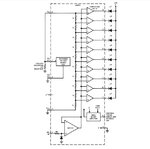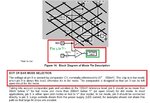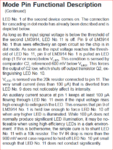d123
Advanced Member level 5
Hi,
The LM3914 can light all LEDs/activate all outputs on a rising input similar to a VUmeter kind of thing or function more like a set of window comparators and only light one LED/activate one output at a time, e.g. 1V to 2V input is only output 1 on, 2V to 3V input is output 2 on but 1 off, 3V to 4V input is output 3 on but 1 and 2 off, and so on.
Tried to think about it, did a few simulations with the basic schematic shown below and added transistors to consecutively cut off the previous output to emulate dot mode with no success but can't imagine how this is done. Maybe parallel comparators referenced to the next reference voltage up or something? An enable/high Z pin on the comparators in the simplified schematic? Bar mode is easy to simulate, it's the same circuit as the simplified schematic.
Can anyone guess - or better yet, do they know - what the little box that says dot/bar logic may actually contain so as to perform the dot function, please?
Thanks.


The LM3914 can light all LEDs/activate all outputs on a rising input similar to a VUmeter kind of thing or function more like a set of window comparators and only light one LED/activate one output at a time, e.g. 1V to 2V input is only output 1 on, 2V to 3V input is output 2 on but 1 off, 3V to 4V input is output 3 on but 1 and 2 off, and so on.
Tried to think about it, did a few simulations with the basic schematic shown below and added transistors to consecutively cut off the previous output to emulate dot mode with no success but can't imagine how this is done. Maybe parallel comparators referenced to the next reference voltage up or something? An enable/high Z pin on the comparators in the simplified schematic? Bar mode is easy to simulate, it's the same circuit as the simplified schematic.
Can anyone guess - or better yet, do they know - what the little box that says dot/bar logic may actually contain so as to perform the dot function, please?
Thanks.



